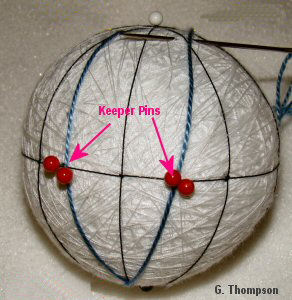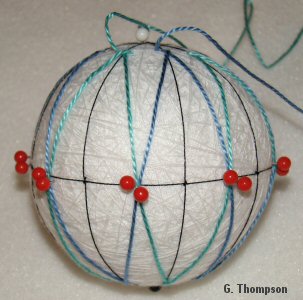Using Keeper Pins
Some Temari stitching techniques and patterns call for using keeper pins... that is, pins that are placed in the mari not so much for indicating where to take a stitch, but for holding threads in place as you work a design or stitch. Without a doubt, keeper pins can be a
 bane or a blessing; some
stitchers think they cause more hindrance than help because the thread
gets caught on them. Others have pins all over in the temari they are
working on, and more find a happy medium (it's everyone's personal
choice - there is no "keeper pin police"). If you don't like using them
and can achieve the stitch or design outcome without them, that's fine.
You will see keeper pins called for in many pattern directions so it's
worth knowing what they are needed for.
bane or a blessing; some
stitchers think they cause more hindrance than help because the thread
gets caught on them. Others have pins all over in the temari they are
working on, and more find a happy medium (it's everyone's personal
choice - there is no "keeper pin police"). If you don't like using them
and can achieve the stitch or design outcome without them, that's fine.
You will see keeper pins called for in many pattern directions so it's
worth knowing what they are needed for. The most common use of keeper pins is using a pair of pins to hold bundles of threads together when they cross each other (often at the equator line). Jyouge Douji (continuous north-south stitching) is the most common example. As you build up rows, a bundle of thread is created at each place that the threads cross each other. It is important to keep these threads in place, and
 to keep them
neat (flat and aligned) as you work, since later on you will finish them
in some way - perhaps either over-stitching or wrapping. How neatly the
appearance of the design turns out will be determined by how well
controlled the bundles of threads were as your worked.
to keep them
neat (flat and aligned) as you work, since later on you will finish them
in some way - perhaps either over-stitching or wrapping. How neatly the
appearance of the design turns out will be determined by how well
controlled the bundles of threads were as your worked. Note that keeper pins are helpers - make them work for you. You will most likely need to adjust them as your work progresses and more threads build up between them. It's fine to open up the pins a bit and reposition them as needed. It's also helpful to place one above and one below the equator.
While it is possible to "groom" the thread alignment after you are through stitching, it usually cannot be done to the degree needed to correct not keeping the threads neat to start with. This will ultimately affect the outcome of your design, no matter how precise your other stitching is. In situations like this the keeper pins are usually kept in place until the design is complete and whatever anchor you are using on them is completed.
The other common use of keeper pins is when working Tsumu Kagari, commonly known as "spindles". Once the spindle shape has been set up after a few rows and the design element is
 stable, the
pins can be removed. This can happen other times when keeper pins are
needed - they may not be needed through the whole project so you can
remove them after they serve their purpose.
stable, the
pins can be removed. This can happen other times when keeper pins are
needed - they may not be needed through the whole project so you can
remove them after they serve their purpose. While larger-sized head pins are shown in the photos, it is for illustration purposes. You'll find that smaller-head pins are easier to use. First, it's easier to see around the smaller ones when placing stitches. More importantly, the smaller heads will be a bit more forgiving in terms of snagging the threads as you stitch. There is no getting around this, and the purpose of the keeper pins far outweighs the inconvenience of the threads catching the pins as you work; just work carefully. Pull your thread through a bit more slowly as you complete the stitch so it doesn't twist or tangle, which makes it more likely to catch on the pins. Be picky about your pins: use ones with smooth heads and no other damage. Metal or glass head pins are usually smoother than plastic. Lastly - when stitching and you are pulling your thread through, turn your mari so the pin heads are upside down - works like a charm to lessen snagging, since the thread usually dangles below the pins.
This
is a TemariKai.com Printable Page; © 2014, all rights reserved.
Right click to print one copy for personal use.
Last updated 1/2014 © 1998 - 2014 TemariKai.com, G. Thompson/PuffinStuff, Inc.
